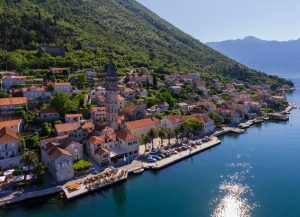Mountainous Montenegro
The Adriatic proves to be an interesting cruising area and the weather adds to the experience. This a useful report fro those planning an excursion to the Adriatic.
Published 8 years ago, updated 7 years ago


From Albania to the south, Bar is the first Port of Clearance into Montenegro, but we were making the best of deteriorating conditions to make our way North. Calls we made on VHF 16 went without reply. Further on was Budva, and again we had no reply to our calls, however, we made a night entry; the navigation marks were quite satisfactory. We anchored up on the NW side of the marina and rode out the stormy conditions. Early the next morning we set off again in calmer conditions that again deteriorated with strong Northerlies.
Our approach to Boka Kotorska was our first real look at Montenegro and we were impressed by the scenery along the extensive waterways to Kotor. In this area, we were experiencing the bora, where the wind speeds went over 30 knots in the gusts. We were surrounded by rising mountains and a green landscape.
First port of call – Kotor
Kotor is a delightful harbour with modern amenities and interesting Venetian ruins running up the steep hillsides. Small cruise ships frequent this picturesque inlet.
At Kotor, we went alongside the lee of the main wharf to clear in with Customs and Immigration. We had arranged to pick up crew here and it was all done quite efficiently, and cost less than 40 Euros and without recourse to an agent.
Later we were asked to move to the marina, where the charge was 50 Euro for the first night. Two subsequent nights were 40 Euro each.
There were better variety and quality of food here than anywhere else in the Mediterranean. There were a wide variety of nuts, dried fruits and preserves at the markets along the waterfront. The supermarkets were similarly well stocked, particularly the delicatessens with cheeses and cured meats, with the vendors offering samples of their fine fare. We stocked up our freezer and spare spaces for our continuing voyage.
Our priority was to take on diesel fuel, and Kosmas at Porto Montenegro is prompt and well organised. We take on almost 2200 litres at 0.493 Euro per litre plus 0.06 Euro/litre commission. They also supply other petroleum products, so we take 2 x 20-litre drums of SAE30 Monograde Shell Rimula for Euro 178 which is also reasonable.
After taking on fuel we have to depart from Montenegro, so our clearances are efficiently done and at no cost. We took the opportunity in the harbour to check and clean our propeller and rudder.
At Porto Montenegro, there is a larger upmarket marina complex with a variety of large vessels, with Russian, Maltese and British flags with the facilities to service them. We departed Montenegro feeling that we could have spent longer exploring this scenic country, and enjoying the local cuisine.
Leaving the Adriatic
Making our way out of the Adriatic we head west to pick up a half knot current along the coast of Italy, then south to the Otranto Straits and of course the Northerlies have abated. There is some traffic out of the Italian ports of Taranto and Brindisi.
The winds have been fickle in the Adriatic and we have hopes for more consistent winds in the Mediterranean Sea for our next leg to Malta, three hundred miles to the southwest. In Malta, we have arranged to pick up some stern tube oil, a product we have failed to source elsewhere, then from there to Gibraltar, our last stop before our Atlantic crossing.
Robert Burn
Related content
Related to following destinations: Bar, Budva, Kotor, Montenegro




